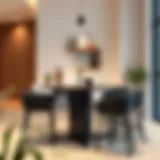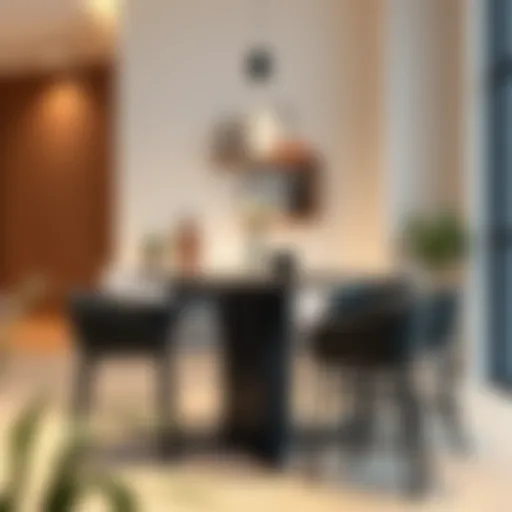Understanding Bookcase Support Brackets for Shelving
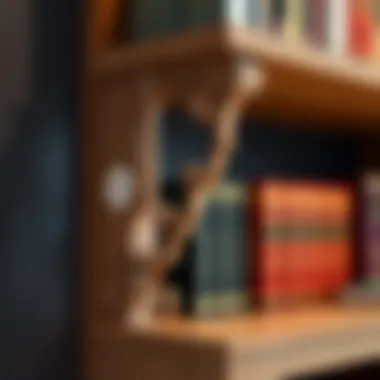

Intro
In today’s world, the role of furniture goes beyond mere utility; it intertwines with the essence of a home’s aesthetic. Among the unsung heroes of this relationship are bookcase support brackets. These small but significant components not only bear the weight of our literary treasures but also contribute to the decor and structural quality of our shelving solutions.
Their importance is often overlooked, yet understanding the styles, functions, and installation intricacies of these brackets can greatly enhance the way one approaches home organization and decoration.
The consideration of bookcase support brackets is paramount for homeowners, designers, and DIY enthusiasts alike. As this article unfolds, we will navigate through furniture trends, delve into the varied styles that influence bracket design, and provide practical advice for selecting and maintaining these essential support structures.
Understanding Bookcase Support Brackets
Understanding bookcase support brackets is crucial for anyone looking to enhance their home decor while ensuring practicality. These brackets are more than mere afterthoughts; they provide essential support for shelves that can hold various items, from treasured books to decorative elements. Homeowners and designers alike must consider both the functional and aesthetic roles these brackets play.
When it comes to crafting a beautiful and practical shelving solution, choosing the right brackets can make a significant difference. The benefits of understanding these support systems include selecting brackets that not only hold weight but also blend seamlessly with interior styles.
Definition and Purpose
A bookcase support bracket is a piece of hardware designed to connect shelves to walls or other structural elements. These brackets come in various shapes, sizes, and materials, each serving the primary function of supporting weight. Their purpose extends beyond mere support; they ensure safety and stability, preventing shelves from sagging or collapsing under pressure. Without proper brackets, even the most elegantly designed shelves can become unstable, compromising both function and aesthetics.
The design of brackets can also influence the overall appearance of a space. Take the time to notice how subtly they integrate into a room's style, whether they are sleek and modern or ornate and traditional. In essence, they maintain the balance between utility and design, contributing significantly to the visual language of a home.
Historical Development
The evolution of bookcase support brackets can be traced back to ancient civilizations, where simple wooden beams were used to create shelving in homes and public places. As construction techniques advanced over centuries, so did the design of brackets. In the Middle Ages, wrought iron brackets became popular, reflecting the craftsmanship of the time.
By the 19th century, the Industrial Revolution ushered in new materials and manufacturing processes, allowing for mass production of metal brackets. These innovations enabled more complex and decorative designs, contributing to their aesthetic appeal. The shift from purely functional to more decorative brackets was significant. Today, modern bookcase support brackets come in a mix of materials like metal, wood, and even plastic, each tailored to meet the needs of contemporary furniture design.
During the latter half of the 20th century, the rise of DIY culture further changed the landscape. Simple installation methods encouraged homeowners to explore various designs and styles, recognizing brackets' versatility. The modern advancements have led to brackets that are not only sturdy but also visually engaging, emphasizing the importance of understanding their historical context and current applications.
Types of Bookcase Support Brackets
Understanding the different types of bookcase support brackets is paramount, as this knowledge significantly influences both functionality and aesthetic charm in any shelving setup. Each type serves a specific purpose, offering varied advantages depending on the materials of your shelves, the decor of your living space, and the weight they need to support. As we navigate through these types, homeowners, designers, and DIY enthusiasts will find practical insights that can guide their choices toward creating adaptive, lasting shelving solutions.
L-Brackets
L-brackets stand as one of the most popular options in the realm of bookcase support. Their simple yet functional L shape provides sturdy reinforcement for horizontal shelves.
When selecting an L-bracket, one of the first considerations is weight capacity. These brackets come in various sizes and strengths. Made from materials like metal, they can support hefty volumes of books and other decorative items. Proper installation is key — placing the brackets at both ends of the shelf maximizes stability, ensuring that your precious items don’t end up taking an unscheduled tumble.
- Advantages of L-Brackets:
- Superior weight distribution.
- Easily available in hardware stores.
- Cost-effective solutions for both DIYers and homeowners.
However, installation errors can lead to disappointing results. One common mistake is failing to correctly align the brackets with wall studs when mounting, which could potentially lead to structural failure. It's best to double-check placements and ensure that the mounting is well within the carrying capacity of your brackets.
Floating Brackets
Floating brackets, on the other hand, offer a much more streamlined aesthetic by hiding the support hardware completely. This type typically consists of hidden brackets inserted into the back of the shelf, creating the illusion that the shelves are levitating without visible support. The appeal is particularly pronounced in modern and minimalist designs.
To successfully use floating brackets, it’s essential to consider the shelf thickness and wall type. Standard mounting often involves studs in the wall, ensuring that the brackets are safely anchored and that the shelves maintain their intended use without concern.
"Floating shelves maximize the storage potential while enhancing a clean, contemporary look in any room."
One solidarity point to remember: floating brackets may not hold as much weight as traditional styles, which leads many homeowners to avoid using them for particularly hefty items like textbooks or bulky decor. Therefore, balance aesthetic desires against practical needs when choosing floating brackets.
- Characteristics of Floating Brackets:
- Visual spaciousness created by hidden supports.
- Perfect for lighter weight shelves.
- A wide range of styles available to match decor.
Decorative Brackets
Decorative brackets blend functionality with art, transforming a simple support system into an integral part of the overall design. These brackets come in diverse styles, materials, and finishes, often acting as a focal point in a room.
Classic wrought iron, ornate wood carvings, or sleek modern styles; decorative brackets can elevate a simple bookshelf arrangement into an eye-catching display. They are particularly useful in settings where the appearance of the shelf is as crucial as its utility.
- Benefits of Decorative Brackets:
- Enhances decor by adding visual interest.
- Offers various design choices to suit personal taste.
- Can be made from diverse materials that reflect a unique style.
While these brackets require care in selection — as their aesthetic quality may detract from their load-bearing ability — thoughtful integration ensures that support systems do not compromise the beauty of the shelving.
As you explore the various types of bookcase support brackets, it's imperative to match style with substance, keeping in mind what aesthetic appeal you want to achieve, balanced against practical loading needs. Ultimately, the right choice contributes to a well-supported and visually engaging shelving solution.
Materials Used in Bracket Construction
When it comes to bookcase support brackets, the choice of materials is not merely an afterthought; it can significantly affect durability, aesthetics, and overall performance. Understanding the characteristics of various materials helps homeowners and designers select the most suitable options for their unique needs. From the solid feel of wood to the sleek look of metal, and the versatility of plastic, each material presents distinct advantages and considerations.
Wood

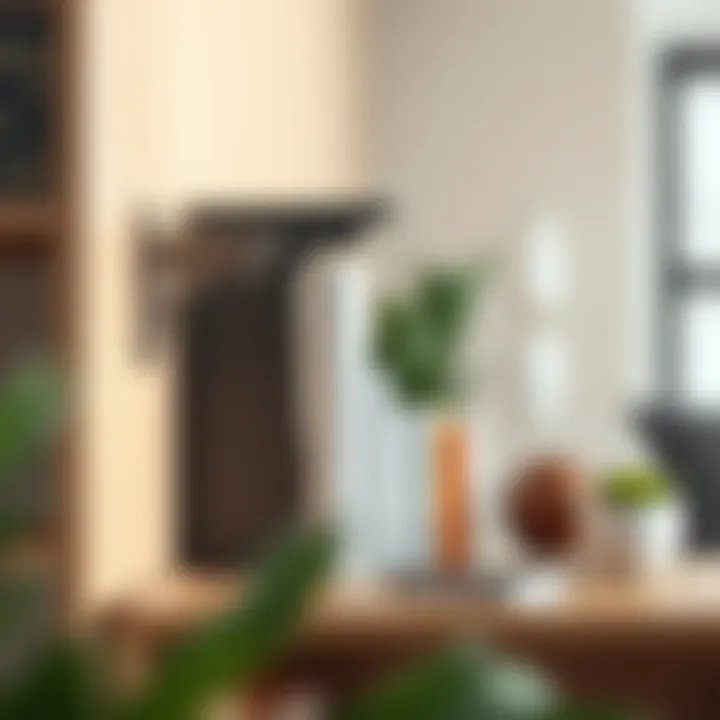
Wooden brackets are often cherished for their natural warmth and versatility. They can provide a classic touch that fits well in various decors, whether rustic or modern. One of the primary benefits of using wood is its ability to bear weight. For an avid reader with a sprawling collection, wooden brackets can lend the necessary support without skimping on style.
However, there are some important considerations.
- The type of wood matters; varieties like oak or maple may have superior strength compared to softer woods such as pine.
- The finish is equally crucial, as untreated wood can absorb moisture, leading to warping over time.
- Regular maintenance, like polishing and checking for wear, become essential to preserving the longevity of wooden brackets.
Additionally, they can be painted or stained to match any color scheme, providing both function and aesthetic appeal.
Metal
Metal brackets stand out for their strength and durability. Commonly crafted from steel, aluminum, or wrought iron, these brackets can support substantial weight, making them ideal for heavier items. They are especially popular in modern designs, lending an industrial flair to any bookcase.
Metal’s advantages include:
- Stability: Resistant to warping and buckling.
- Variety of Finishes: Powder coating or galvanization keeps them safe from rust and corrosion while allowing for aesthetic customization.
- Minimalist Design: Provides a sleek, unobtrusive look.
Despite these positives, some caution is warranted. Metal can become cold and may not naturally meld into every home environment. Sharp edges can also be a concern, particularly for families with young children.
Plastic
Plastic brackets present an interesting alternative in the equation of bookcase support. While they may not be the first material that comes to mind, their lightweight and flexible nature could cater to specific needs. Often made from high-density polyethylene or polypropylene, these brackets offer a surprising amount of strength for their weight.
Among the benefits:
- Cost-Effectiveness: Plastic brackets are generally less expensive to produce, making them accessible for budget-conscious projects.
- Weather Resistance: Ideal for outdoor shelving where exposure to the elements is a consideration.
On the flip side, the visual appeal of plastic may not resonate with everyone. They can lack the gravitas of wood or metal, possibly leading to a less cohesive look in more formal settings. Furthermore, while they can support moderate weight, they may not be suitable for heavy books or large decorative items.
In summary, the material selection for bookcase support brackets influences not just the functionality but the overall aesthetic harmony of a space. Homeowners, designers, and DIY enthusiasts ought to weigh these considerations pragmatically, aligning their choices with both practical needs and design aspirations.
Installation Techniques
Proper installation of bookcase support brackets is essential in ensuring that the weight of the shelves is evenly distributed. This not only maximizes the shelving unit's functionality but also enhances its visual appeal. By considering various installation techniques, users can avoid potential pitfalls that could lead to structural failures or damage to the surrounding area. Correct installation also provides peace of mind, eliminating worries about possible accidents from poorly secured brackets.
Required Tools
Before embarking on the installation journey, it’s crucial to gather the right tools. Each tool plays a distinct role in ensuring that the process goes efficiently and without hitches. Here is a list of essential tools you’ll need:
- Drill: A reliable cordless drill is a must for creating holes and securing screws. Speed and ease of use are important here.
- Screwdriver: Both flat-head and Philips screwdrivers should be at hand, as they help in tightening and loosening screws.
- Level: Ensuring that your brackets are parallel is key for an attractive finish. A small bubble level can help you achieve that balance.
- Tape Measure: Accurate measurements are indispensable in any project to avoid misalignment.
- Pencil: For marking your drill points. That way, there’s no guesswork once you start drilling.
- Stud Finder: This device helps you identify the best places to secure your brackets, allowing you to fasten them to wall studs for optimal strength.
Having all these tools ready will streamline the installation process, making it smoother and more efficient.
Step-by-Step Process
With your tools lined up and ready, it’s time to get into the nitty-gritty of the installation process. Following each step carefully not only makes the procedure easier but also guarantees an end result that will hold up under weight. Here’s how to do it:
- Determine Placement: More than just a visual consideration, think about what will go on the shelves. The weight of books or decorative items will influence bracket placement. For instance, if your bookcase will hold heavy encyclopedias, spacing brackets closer together can provide added support.
- Mark the Wall: Use your tape measure to mark the desired height. Use the pencil to draw light marks where the brackets will go.
- Locate the Studs: Utilize your stud finder to ensure you’re attaching the brackets to a sturdy surface. Mark these spots to guide your drilling.
- Drill Holes: Get your drill and create holes at the marked points. Make sure the size of the hole matches the screws you’ll be using, so they fit snugly.
- Attach the Brackets: Align the bracket holes with the drilled holes. Insert screws through the brackets into the wall. Ensure that each screw is tightened well, but avoid overtightening as it may strip the holes.
- Use the Level: Before finally securing everything, double-check with the level to make sure everything is straight. Adjust as needed before fully tightening.
- Install the Shelves: Place the shelves onto the attached brackets. Gently test their stability by placing a few lightweight items to ensure everything can handle the weight before you pile on those heavy tomes.
- Final Checks: Once the shelves are loaded, keep an eye out to catch any signs of bending or warping, which could suggest a need for reinforcement or readjustment.
Following these detailed steps can make the installation process straightforward and successful, providing a safe and sturdy setup for your bookcase.
"Planning is the key to success; without it, your dreams may crumple like an unsteady shelf."
These techniques aren’t just helpful for domestic settings; they can also apply when setting up bookcases in offices, libraries, or display areas. A meticulous approach ensures that brackets achieve their purpose—blending functionality seamlessly with style.
Factors Influencing Bracket Selection
Choosing the right support bracket for a bookcase is not just a matter of preference; it's a crucial factor in ensuring the entire setup is functional and visually appealing. Factors such as weight capacity, aesthetic compatibility, and environmental conditions play significant roles in the decision-making process. Each of these elements can drastically affect the longevity and utility of the bookcase, making it vital for homeowners and designers to consider them carefully.
Weight Capacity
When selecting bookcase support brackets, understanding their weight capacity is paramount. Brackets vary widely in how much load they can handle, from lightweight offerings designed for consistent books and decorative items to robust brackets engineered to support heavy volumes and other substantial objects.
- Assessment of Needs: Before making a decision, it’s advisable to assess the intended load. A simple calculation of the total weight of the books and items to be placed on the shelf is essential. For instance, a collection of hardcover novels can quickly pile up to significant weights.
- Testing Limitations: Each bracket comes with specific ratings. For example, a standard metal L-bracket might hold between 50 to 100 pounds when installed correctly, while floating brackets typically support less due to their design. It’s wise to err on the side of caution; if in doubt, choosing a higher weight capacity will prevent future mishaps, ensuring that shelves do not sag or collapse under pressure.
Remember, it’s better to over-engineer than to deal with a fallen shelf full of treasured books.
Aesthetic Compatibility
Beyond functionality, aesthetic appeal is another critical factor when selecting brackets. The right brackets can enhance the visual aspect of a room, making a statement as much as the books themselves.
- Style Matching: Homeowners should consider the overall design theme of their space. A modern loft may benefit from sleek, minimalist floating brackets, while a traditional study could be complemented by ornate, decorative brackets made from wrought iron.
- Color Schemes: Additionally, matching or contrasting colors between the brackets and the bookshelves contributes to the composition. For instance, a dark wood shelf might look stunning against golden brackets, but those must also be sturdy enough to support a moderate amount of weight.
Understanding the delicate balance between compatibility and functionality doesn’t have to be tricky if one keeps it in mind during the selection process.
Environmental Factors
Lastly, consider the environmental factors that could influence the choice of a bookcase support bracket. Depending on where the bookcase is positioned, various conditions must be contemplated.
- Humidity and Temperature: A literary haven located in a tightly sealed, humid basement presents different requirements compared to a sun-drenched living room. It’s essential to choose brackets that are not only robust but also resistant to rust or warping. Metals treated with powder coatings can withstand moisture better than untreated versions. Likewise, wooden brackets may swell or shrink based on humidity, impacting their performance.
- Placement Considerations: The proximity to heating vents or windows means brackets could also be exposed to heat variations. Keeping nearby conditions in mind will help avoid potential damage to both brackets and the shelves themselves.
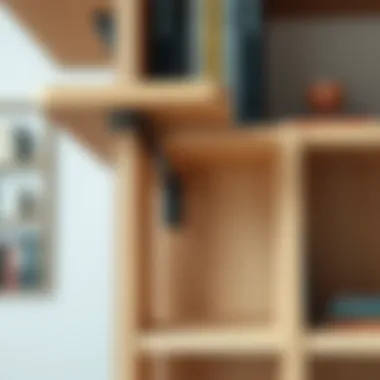
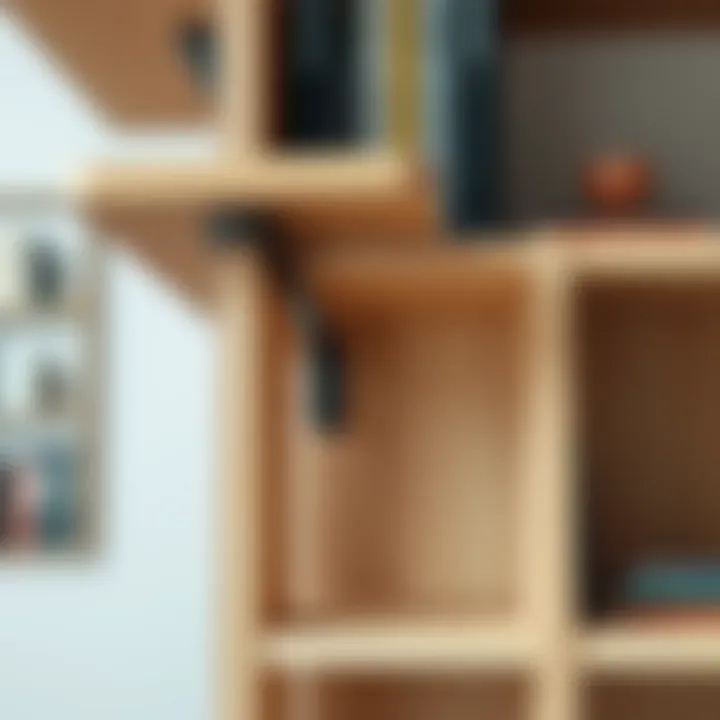
When integrating these considerations into the selection process, homeowners can ensure a harmonious blend of form and function that will stand the test of time.
Common Mistakes in Bracket Use
When diving into the world of bookcase support brackets, understanding common mistakes in bracket use is essential. These errors can undermine the structural integrity of shelves, hampering their effectiveness and potentially leading to costly repairs or accidents. Homeowners and designers alike should be aware of these pitfalls to create secure and visually appealing shelving solutions.
Underestimating Load
One of the most critical mistakes is underestimating the load that a bracket can withstand. Many individuals, eager to showcase their literary treasures or decorative items, may not give enough thought to the sheer weight these pieces exert on the brackets. It’s not just about stacking a few books on a shelf; consider the total weight of your collection or what the shelf will hold.
When selecting brackets, it's invaluable to look at the manufacturer’s guidelines regarding weight capacities. Ignoring this can lead to disaster. For example, if a bookcase shelf is designed to hold a maximum of 50 pounds, but it's loaded with 70 pounds of books, that bracket is destined for failure.
"A stitch in time saves nine; measuring twice and loading once means you can avoid unwanted mess and damage."
Improper Installation
Another frequent blunder is improper installation of the brackets. It may sound straightforward, but the devil is in the details. Poor alignment or insufficient anchoring in the wall can lead to wobbling shelves or, worse, complete failure. It’s not just about drilling holes and slapping brackets up there; it requires careful measurement, level checks, and sometimes even pre-drilling holes for proper fit.
Common mistakes include:
- Skipping the Stud Finder: Not using a stud finder can result in attaching brackets solely to drywall, which is not sturdy enough for holding significant weight.
- Using Incorrect Anchors: Standard anchors may work in some scenarios, but for heavier loads, toggle bolts or heavy-duty anchors are essential to provide secure attachment.
- Failure to Level: If brackets are not installed level, the shelves will tilt, causing items to slide off or, again, risk a total shelf collapse.
Understanding and addressing these common mistakes creates a safer, more reliable storage solution for all manner of books and collectibles, ensuring they stay right where you placed them.
Innovative Bracket Designs
Innovative designs in bookcase support brackets play a crucial role in both functional and aesthetic dimensions. As homeowners and designers seek to optimize their spaces, the evolution of bracket designs reflects not just technological advancements but also a shift toward more personalized styles that can harmonize with diverse interiors.
Modern Trends
The landscape of bookcase support brackets has changed significantly in recent years. One of the most prominent trends is the embrace of minimalist designs that favor clean lines and subtle profiles. This works well in contemporary interiors where clutter and excessive decoration are avoided. For example, brackets that appear almost invisible can allow the beauty of the shelves and the books themselves to shine.
Another notable trend is the increased popularity of mixed materials. Brackets combining metal and wood create a striking contrast, offering strength while still providing warmth to a space. Designers are also integrating adjustable or modular systems, which cater to the changing needs of homeowners. The idea that a shelf can adapt as requirements evolve gives added significance to the design, proving that function and style can walk hand in hand.
"In innovative design, it’s not just about what you can see; it’s also about what you can’t. The best brackets support without drawing attention to themselves."
Sustainable Options
Sustainability is becoming increasingly relevant in design choices across the board, and bookcase support brackets are no exception. Homeowners today are more attuned to environmental impacts than ever. Using recycled materials in bracket construction not only lessens the ecological footprint but also can add a unique character to each piece. For instance, brackets made from reclaimed wood or upcycled metal not only support shelves but tell a story of sustainability and resourcefulness.
Moreover, sustainable designs also encompass the principles of durability. Investing in quality brackets made from long-lasting materials ensures that fewer replacements will be necessary over time, ultimately reducing waste. Consumers should also be aware of the sourcing of raw materials, prioritizing options that adhere to ethical guidelines and local manufacturing practices. It’s about taking a responsible approach, preserving both materials and style for future generations.
In summary, being aware of innovative bracket designs helps homeowners make informed decisions that enhance both functionality and the visual appeal of their living spaces while aligning with personal values and contemporary trends.
Maintaining Bookcase Brackets
When it comes to the longevity and performance of bookcase support brackets, maintenance plays a pivotal role. Just as one would routinely service a cherished vehicle or keep up with a garden, the same principle applies to the brackets that hold up bookshelves. Ensuring these components remain secure and visually appealing can lead to more than just aesthetic benefits; it can ultimately save time and prevent accidents.
Regular Checks
Regular checks on your bookcase brackets are essential to ensure they are functioning as intended. With the daily hustle and bustle of life, it’s easy to overlook these sturdy little warriors holding your beloved books. Here’s why these inspections matter:
- Safety: A loose bracket can lead to a shelf collapsing, potentially causing injury or damaging prized possessions. Regularly inspecting the brackets can help detect any signs of wear and tear before they turn into accidents.
- Performance: Over time, the weight of books and decorations can warp or unbalance brackets. Checking that they are properly aligned helps avoid future adjustments and maintains the visual symmetry of your setup.
- Longevity: Giving brackets a little TLC can extend their lifespan. Assessing their condition can alert homeowners to potential issues that might weaken the structural integrity over time.
In practice, consider setting a schedule for inspections—perhaps every six months or whenever you do a seasonal deep clean. During these checks, look for any rust, loose screws, or signs of material fatigue. A simple tightening here and there can make all the difference, allowing them to last long into the future.
Cleaning Techniques
Cleaning your bookcase brackets isn’t just about keeping them shiny; it’s a way to prevent buildup that can lead to deterioration. Here are some simple techniques that work wonders:
- Dirt and Dust Removal: Start with a soft, dry cloth to wipe away dust. Use a microfiber cloth for those hard-to-reach areas where dirt likes to linger, especially around screws and joints.
- Mild Soap Solution: If you notice any grime or stains, mix a few drops of mild dish soap with warm water. Dampen a cloth in the solution, then wipe down the brackets. Avoid soaking them; moisture can cause issues, especially with metal brackets prone to rust.
- For Metal Brackets: Consider using a metal polish to restore shine and protect against corrosion. This can be particularly beneficial in humid environments where moisture is prevalent.
- Wood Brackets Care: For wooden brackets, a wood polish or conditioner can help maintain their finish and prevent cracking. Regular treatment will nourish the wood and keep it looking fresh.
*Remember, a little cleaning goes a long way in prolonging the life of both your brackets and the shelves they support. By taking these small steps regularly, you maintain not only the function but the beauty of your home decor.
For further information on maintenance tips, you might explore Wikipedia and Britannica for comprehensive guides.
Real-Life Applications of Brackets
Bookcase support brackets are not just minor players in the shelving game; they are the unsung heroes that hold everything together. Understanding their applications in real life gives us insight into both practical and creative aspects that might elude those only focused on appearance. When it comes to setting up a bookcase, the choice of brackets can influence not only the sturdiness of the shelves but also the overall aesthetic of the space. It’s a balance between functionality and style, where every bracket choice matters.
Home Library Setup
Creating a home library is more than just a hobby; it’s a sanctuary for book lovers. The design here isn’t solely about books but also about how you display them. When planning a library, the placement and type of brackets can open up possibilities for unique layouts. By utilizing floating brackets, you can achieve a sleek, modern look while allowing for an airy feel, making it easy to showcase book collections or cherished decor.
- Adjustable brackets can be a game changer, providing the flexibility to change the height of shelves as needed. This is particularly useful when you're dealing with books of various sizes or incorporating other decorative items alongside your literary favorites.
- Strength is key; heavy-duty metal brackets are essential for storing large coffee table books or a few precious first editions without the risk of collapse.
- Staggered arrangements utilizing decorative brackets can enhance visual interest, leading to a dynamic and inviting library environment.
Maximizing space efficiency while maintaining comfort and elegance is the aim. This combination transforms mere wooden beams into stylish displays that reflect the homeowner's taste.
Office Shelving Solutions

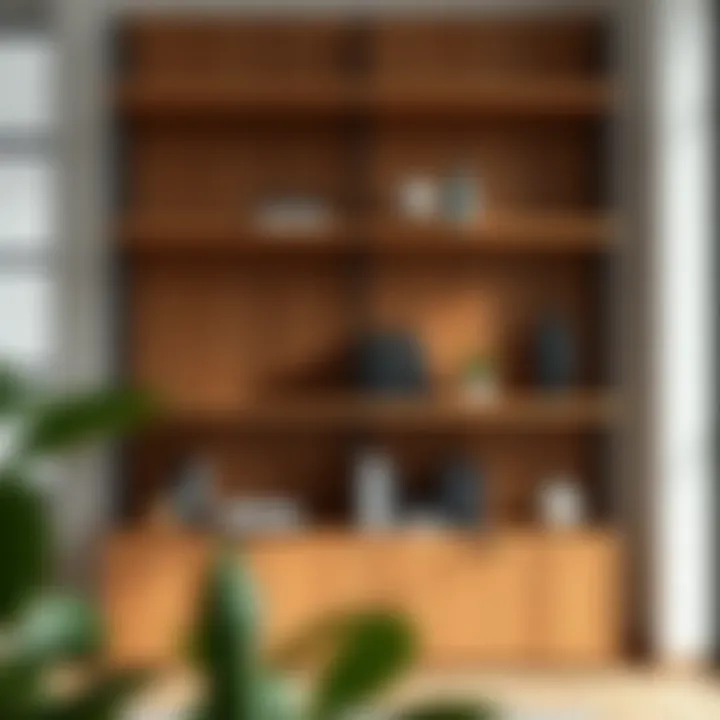
In an office setup, the functionality of bookcase support brackets becomes paramount. The office is a place where organization meets professionalism, and the shelving system must reflect that while ensuring accessibility.
Consider these factors:
- Weight capacity is crucial as offices often feature more than just documents. From binders to tech gadgets, a robust bracketing system is needed to prevent disaster.
- Opting for industrial-style brackets may serve dual purposes by adding a trendy aesthetic while providing unmatched stability. This style pairs well with modern or rustic office themes.
- When it comes to aesthetic compatibility, choosing brackets that complement the office decor can imbue a sense of cohesion in design, ultimately influencing productivity.
To put it succinctly, whether in a home library or an office, the choice of bookcase support brackets impacts not just functionality but also the ambiance of the space. They hold the power to elevate the environment, reinforcing the idea that good design is both useful and beautiful.
"A well-designed space can inspire creativity and enhance productivity, reminding us that even the smallest details, like brackets, matter."
For more insights on home organization and design, check out Wikipedia on Shelving.
Finale
Ultimately, integrating support brackets with care, whether in casual reading nooks or professional workspaces, can transform an ordinary bookcase into a vital component of your home's function and aesthetic.
Budget Considerations
When it comes to setting up a bookcase, budget considerations play a pivotal role in the selection of support brackets. A well-planned budget ensures that you balance both functionality and aesthetics without straining your wallet. It's essential to understand that opting for the cheapest options may not always yield the best results. Here are some significant elements to consider when navigating this terrain:
- Material Quality: The bracket’s material can vary widely in price. For example, while plastic brackets may cost less, their long-term durability might not match that of sturdy metal or hardwood options.
- Design Complexity: Oftentimes, decorative brackets come with a higher price tag. Assess whether the extra cost aligns with your overall design goals.
- Load Capacity Needs: Your choice should also reflect the weight they are expected to support. Higher-capacity brackets may cost more, but they are essential for stability, especially if your bookcase is laden with heavy tomes.
- Installation Costs: Depending on your skill level for DIY tasks, you might want to factor in possible installation costs if you choose brackets requiring specialized fittings or tools.
Taking these elements into account will lead you towards making informed decisions that ensure your bookcase stands the test of time while fitting your financial outline.
Cost-Effective Options
Finding cost-effective options for bookcase brackets does not mean compromising on quality. It's about smart shopping and considering your unique needs. Here are a few strategies:
- Search for Discounts: Keep an eye on seasonal sales from retailers, or check websites like reddit.com or facebook.com for communities sharing deals on home improvement products.
- Bulk Buying: If you are planning multiple shelving projects, buying in bulk can save you a bundle.
- Mix and Match: Consider combining less expensive brackets with higher-end ones. For instance, use decorative brackets for the visible shelves, while opting for functional brackets in the less visible layers.
- Repurpose Materials: Think about using reclaimed wood or old furniture parts for support. This not only cuts costs but is also a sustainable choice.
By employing these cost-effective measures, homeowners can achieve a well-supported, stylish bookcase while keeping expenses in check.
Investment in Quality
Investing in quality bookcase brackets is one of the wisest decisions a homeowner can make. While cheaper options may seem appealing at first, they often result in higher costs down the line due to repairs or replacements. Consider these points:
- Durability: High-quality materials, such as stainless steel or solid wood, can withstand heavy loads over time without warping or breaking. This is particularly crucial for avid readers with growing collections.
- Aesthetic Appeal: Well-crafted brackets can enhance the overall look of your shelving. Investing in stylish, high-quality designs means your bookcase will be a focal point rather than an afterthought.
- Long-term Savings: While the initial investment may be higher, durable brackets often pay off. You won’t need to replace them as frequently, saving you money in the long run.
- Safety: Quality brackets ensure that your shelves remain stable under weight, reducing the risk of accidents that can result from poorly supported shelves.
In summary, while keeping an eye on your budget is crucial, don’t lose sight of the importance of investing in quality. High-quality bookcase support brackets not only fulfill functional needs but also enhance the décor and longevity of your shelving.
Cultural Significance of Bookcase Design
The realm of bookcase design transcends mere functionality; it envelops the essence of culture, history, and personal expression. Bookcases serve as intellectual havens and artistic displays, intertwining elements of practicality with the various narratives they reflect. When one contemplates a bookcase, it can evoke thoughts beyond mere storage; it encapsulates the personality of a space.
At a glance, a well-designed bookcase can mirror societal values and personal aesthetics in remarkable ways. For instance, an abundance of classic literature elegantly displayed might signify a commitment to the timeless virtues of knowledge, while an eclectic mix of contemporary novels and art books may offer insights into a more progressive or innovative worldview. In living spaces, especially, they act as conversation starters and reflect the owner's life history and experiences.
The choice of a bookcase isn’t solely about books; it’s about how one chooses to present their life’s journey. Furniture has a memory, and it narrates who we are. Bookcases function as vital extensions of our identities and can play a crucial role in designing inspirational environments.
Historical Influences on Modern Design
The lineage of bookcase design stretches back centuries, continuously influenced by art movements and cultural shifts. From the lavish, hand-carved wooden bookcases of the Renaissance to the minimalist shelves seen in Contemporary design, each era has left its mark.
- Renaissance Influence: During this period, bookcases were often grand, with intricate carvings representing the wealth and status of the owner. They were often commissioned for public libraries or stately homes and were works of art in themselves.
- Modernism: The early to mid-20th century saw a departure from ornamentalism. Clean lines, functional forms, and industrial materials were celebrated. Designers like Charles and Ray Eames brought functionality to the forefront, suggesting that beauty lies in simplicity.
- Postmodern Approach: The late 20th century ushered in an era of eclectic tastes, where designers like Ettore Sottsass emphasized bold colors and unconventional structures. The blend of irony and nostalgia opened doors to varied interpretations.
In contemporary design, not only do we draw influences from histories past, but we also adapt and meld them to create something uniquely relevant. What was defined by ornate splendor now dances with minimalistic themes, showing that the past informs our current choices and future innovations.
Symbolism of the Bookcase
Beyond being mere furniture, bookcases are imbued with layers of symbolism. Consider how they transform rooms into libraries of the mind, standing tall as guardians of wisdom.
- Knowledge and Learning: A bookcase signifies a love for knowledge and education. The more books it houses, the more it demonstrates a commitment to intellectual growth and curiosity.
- Curation of Identity: Every book stored speaks to personal choices and experiences. Whether this is a collection of philosophy tomes or a selection of fantasy novels, each piece tells a part of the owner’s narrative.
- Cultural Reflection: The materials and styles chosen for bookcases can reflect broader cultural trends. Modern industrial designs incorporate metal and glass, pointing toward contemporary values of sustainability and transparency.
Overall, bookcase design embodies more than just a need for storage; it serves as a cultural artifact, embodying the personal and societal values integral to its owner. Understanding this can inform how homeowners and designers create spaces that resonate with both function and deeper meaning.
Future of Bookcase Support Brackets
The future of bookcase support brackets holds significant promise as both aesthetics and functionality continue to evolve in interior design. Understanding these developments not only benefits homeowners but also provides decorators and designers with critical insights needed to create compelling and innovative spaces. As we untangle the threads of what's ahead, we can see that technological advancements and shifting design preferences will play a central role.
Technological Innovations
Technological progress has paved new avenues in bracket design, ultimately redefining how these fixtures intertwine practicality and style. One of the foremost innovations is the emergence of smart brackets integrated with sensors and automation. These brackets can adjust to the weight of the items placed upon them, providing optimal support and preventing potential collapse of shelves.
For instance, imagine a bracket that could signal when it's carrying more than its suggested weight. Such features ensure that structure and safety don’t go hand-in-hand. As a result, homeowners can store heavier books or other decor items on their shelves with ease, without having to constantly worry about stability issues.
Furthermore, advances in materials technology have led to the creation of lighter, more durable materials with enhanced load-bearing capabilities. No longer are we limited to traditional metal and wood; consider brackets made from carbon fiber composites or reinforced polymers that can offer a sleek look while maintaining strength.
Emerging Trends
The design world is ever-changing, and this is true for bookcase support brackets as well. One of the more exciting trends gaining traction is the focus on minimalism. Brackets are no longer just functional; they’ve become statement pieces that complement the overall decor. Sleek, unobtrusive designs in matte black or brushed steel reflect a modern aesthetic that resonates well in contemporary homes.
Additionally, sustainability is becoming a significant consideration. As eco-consciousness grows among consumers, brackets made from reclaimed materials are on the rise. This trend not only benefits the environment but also adds a unique charm to every piece, often telling a story of its material's previous life.
Moreover, customization is making waves. Imagine being able to choose a color, finish, or even a specific design that perfectly matches your vision for a room. With advances in manufacturing techniques such as 3D printing, this is becoming more and more feasible.
As we move forward, homeowners, designers, and decorators alike should pay attention to these trajectories. The marriage of technology and design signifies an exciting period for bookcase support brackets, creating spaces that are not just functional but also uniquely expressive.




